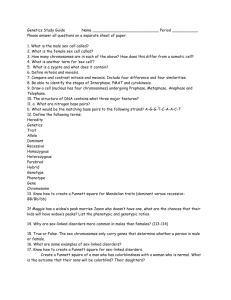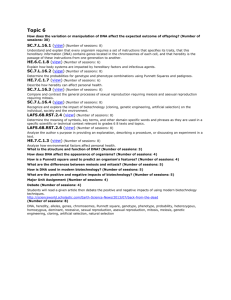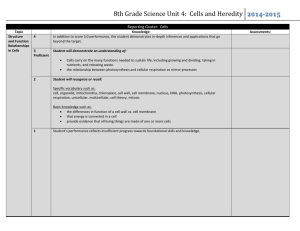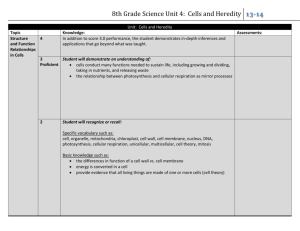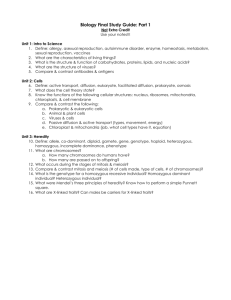Study Suggestions
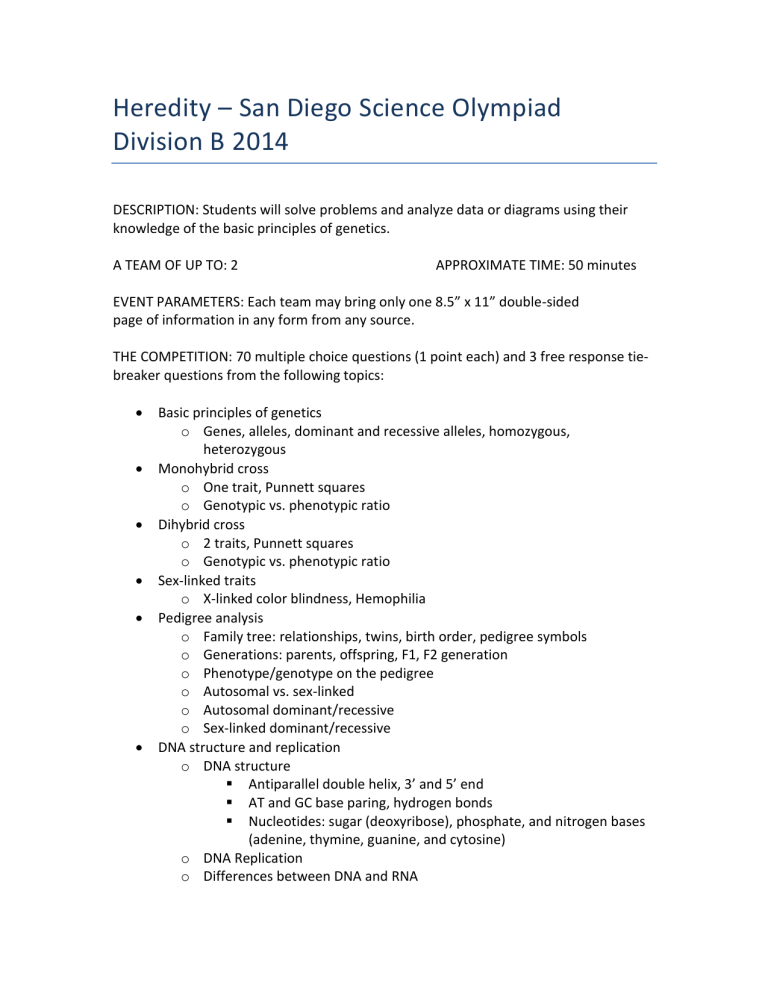
Heredity – San Diego Science Olympiad
Division B 2014
DESCRIPTION: Students will solve problems and analyze data or diagrams using their knowledge of the basic principles of genetics.
A TEAM OF UP TO: 2 APPROXIMATE TIME: 50 minutes
EVENT PARAMETERS: Each team may bring only one 8.5” x 11” double-sided page of information in any form from any source.
THE COMPETITION: 70 multiple choice questions (1 point each) and 3 free response tiebreaker questions from the following topics:
Basic principles of genetics o Genes, alleles, dominant and recessive alleles, homozygous, heterozygous
Monohybrid cross o One trait, Punnett squares o Genotypic vs. phenotypic ratio
Dihybrid cross o 2 traits, Punnett squares o Genotypic vs. phenotypic ratio
Sex-linked traits o X-linked color blindness, Hemophilia
Pedigree analysis o Family tree: relationships, twins, birth order, pedigree symbols o Generations: parents, offspring, F1, F2 generation o Phenotype/genotype on the pedigree o Autosomal vs. sex-linked o Autosomal dominant/recessive o Sex-linked dominant/recessive
DNA structure and replication o DNA structure
Antiparallel double helix, 3’ and 5’ end
AT and GC base paring, hydrogen bonds
Nucleotides: sugar (deoxyribose), phosphate, and nitrogen bases
(adenine, thymine, guanine, and cytosine) o DNA Replication o Differences between DNA and RNA
RNA is single strand - DNA is double strand
RNA has ribose – DNA has deoxyribose
RNA has uracil – DNA has thymine o Gene - protein relationship, mutations
Mitosis o Growth and asexual reproduction o One division – 2 diploid cells o Genetically same as original o Analyze and identify phases of mitosis: prophase, metaphase, anaphase, telophase
Meiosis and gamete formation o Gametes for sexual reproduction o 2 divisions – 4 haploid cells o Independent assortment o Compare Mitosis and Meiosis
Human karyotypes analysis for nondisjunction disorders o Chromosome length, order of chromosomes in karyotypes o Human chromosomes
22 pairs of autosomes
Human sex determination
XY Sex chromosomes, male (XY) vs. female (XX), barr bodies o Nondisjunction disorders
Chromosomes do not separate during meiosis
Missing chromosome: Monosomy
Extra chromosome: Trisomy
Naming nondisjunction disorders
Monosomy 7 (only one chromosome 7)
Trisomy 21 (Down’s syndrome)
XXY Syndrom (Klinefelter’s syndrome)
Co-dominance and incomplete dominance o Co-dominance: more than one dominant allele o Blood types (A,B,O alleles) o Incomplete dominance: flowers blend red/white -> pink
TRAINING MATERIALS
Genetics: Designer Genes and Heredity CD (highly recommended) o Event resources, practice handouts, sample tournaments o $16 + shipping at http://store.soinc.org
Links on Science Olympiad Heredity B website: http://www.soinc.org/heredity_b
Designer Genes Sample Tests (not all topics apply) http://scioly.org/wiki/index.php/Heredity
Getting started: Khan Academy Biology section: o DNA http://www.khanacademy.org/science/biology/evolution-and-natural-selection o Introduction to Heredity, Punnett Square Fun, Sex-Linked Traits, Genetics 101
Part 1-4 http://www.khanacademy.org/science/biology/heredity-and-genetics o Chromosomes, Chromatids, Chromatin, Mitosis, Meiosis, Phases of Mitosis and
Meiosis http://www.khanacademy.org/science/biology/cell-division


